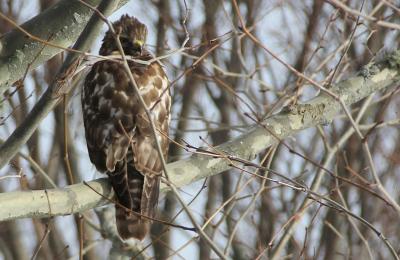Nature Notes: Different Sort of Snowbird

As I write this on Presidents Day in the afternoon while looking out my window across the snow-covered yard to see which bird will show up next, the temperature hovers at 21 degrees. That’s the highest it’s been all day and it’s starting to sink lower. Cornell University’s Laboratory of Ornithology’s annual birdfeeder count took place over the three-day weekend. I haven’t always been a participant, even though the bird lab was started while I was studying ornithology and wildlife conservation at Cornell in the mid-’50s, but I know some who are locally and keep my ear to that grapevine.
Thus far it’s been a slow day for birds. The usual white-throated sparrows and juncos are around. I can see them in my neighbor Ellen Stahl’s yard. For as long as I can remember, more than 20 years now, Ellen has not let a day pass without taking care of the birds. If it were not for her, I probably wouldn’t be writing this column.
These winter birds are well equipped to handle most winter days, but when the snow covers the ground for weeks on end, the cedar, holly, and autumn olive berries have all been taken, and the only berries left are those on the privets, Virginia creeper, honeysuckle, and Asiatic bittersweet, things can get desperate. Hence the need for supplemental feeding. In the old days it used to be breadcrumbs, but now it’s pretty colored cereals that are available in a great many local stores including Wild Bird Crossing in Bridgehampton.
When snow covers the ground, it not only covers forage, but it hides grains of sand and small pebbles. A bird can fill its crop with enough feeder seeds to last through the day in a few minutes, but if it doesn’t have the grit in its gizzard to grind them, it can’t digest them. Thus my wife Julie discovered the sparrows and juncos eating as much of the sand that we put down as slip-prevention on the walkway as seed that we spread. On Friday when she pulled into the driveway after shopping, there was a bird species that we have only seen once before in our yard in the 36 years we’ve been living here — a wild turkey. It was busy eating both small seeds and sand and, judging by the number of turkey tracks scattered around in the semi-fresh snow, the turkey had been there for some time already.
Fresh water is another problem. If Noyac Bay is frozen over solid, and it is, then all of the sources of freshwater that the birds need to hydrate are also frozen. Then the birds start eating the snow, as well, which is not hard to do, as many of the seeds and sand grains have sunken into it. It’s kind of a meal and drink for the homeless, but it suffices for most birds.
The icy conditions are not easy on waterfowl. On Saturday morning I received a call from Wayne Whitmore of Amagansett. He had been to Napeague to check out the coastal birds, having seen some western sandpipers earlier on the ocean beach. He discovered a common loon that was barely alive and wanted to know where to take it. Call the 728-Wild, the Evelyn Alexander Wildlife Rescue Center, was the answer. He started out for that facility with the bird being warmed by his car’s heater, but after only a few miles, the loon succumbed. Sad.
Vicki Bustamante has also been feeding birds for 20 years or so near Big Reed Pond in Montauk. She photo-documents almost all of them. She’s had a great-horned owl roosting around, and every other day or so she finds the remains of the owl’s kill. Today, a fox sparrow, common neither in the winter or summer, was flushed by a hanger-around sharp-shinned hawk, flew into a window while trying to escape and died.
Stationed near the very tip of Long Island, Vicki gets a great variety of birds, many which almost never visit my neighborhood. While keeping track of the birds for the Cornell count, what did she see perched in a tree within eyesight? None other than a red-shouldered hawk. Red-shouldered hawks are among Long Island’s rarest raptors and generally head south with red-taileds and other migratory hawks before winter comes. She was able to get a good shot of it, sent the photo to Angus Wilson, an expert birder, for confirmation, and got a positive reply.
All told, Vicki had 21 different species, not counting crows, gulls, geese, and other flyovers, at her feeder. Cardinals, both males and females, were the most common, at 32, while the 25 house sparrows came in second. Two cardinals were attacked by hawks. One she saved; the other bit the dust. She also had two purple finches along with a couple of house finches. For some peculiar reason goldfinches were missing.
Red-shouldered hawks are rodent, squirrel, and rabbit eaters. She noticed that none of her feeder birds paid much attention to the hawk when it perched nearby, but were all were sent into a frenzy each time marauding sharp-shinned and Cooper’s hawks made a pass.
Larry Penny can be reached via email at [email protected].
